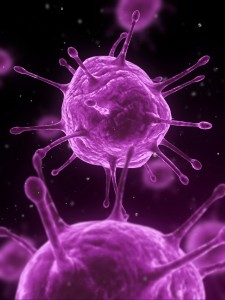The other day, I overheard a woman complaining that her child was sick, and that she thought that the child had caught it from her dog, since the dog was also sick. “That is not how disease works,” I thought to myself. Her child and her dog have different body temperatures, different vectors for transmission, and different cells, proteins, and enzymes for diseases to work on. You have to be a very special kind of person to catch a disease that an animal is experiencing, most of the time. So what if you’re not a special person? What do we have to be worried about? The answer is “Zoonotic diseases,” or conditions that can be passed from animals to people. What are they? Here’s a short list:
Parasites
 You don’t need to worry too much about fleas, but worms are a different story entirely. Hookworms can cause itchiness after skin contact. Roundworm is fairly common in cats and can cause blindness in humans if it goes untreated. Toxoplasmosis (a protozoan parasitic disease) causes flu-like symptoms in humans. Tapeworm transmission is rare, most often if someone accidentally ingests an infected flea. Beyond that, the best way to prevent yourself or your children from getting any of these conditions is to handle your pet’s waste responsibly, wash your hands after contact, and cover up any alternate areas your pet may be defecating, such as children’s sandboxes.
You don’t need to worry too much about fleas, but worms are a different story entirely. Hookworms can cause itchiness after skin contact. Roundworm is fairly common in cats and can cause blindness in humans if it goes untreated. Toxoplasmosis (a protozoan parasitic disease) causes flu-like symptoms in humans. Tapeworm transmission is rare, most often if someone accidentally ingests an infected flea. Beyond that, the best way to prevent yourself or your children from getting any of these conditions is to handle your pet’s waste responsibly, wash your hands after contact, and cover up any alternate areas your pet may be defecating, such as children’s sandboxes.
Fungal Infections
Fungi such as Cryptococcus and Histoplasma Capsulatum can be found outdoors, often in animal droppings. When the droppings dry and are disturbed, the fungus can become airborne and inhaled. These fungi aren’t common in household pets, though. Ringworm, on the other hand, is more likely to be found on dogs or cats, and the fungus can live for a long time without a host, meaning you’ll have to clean house after an infection.
Bacterial Infections
Cat Scratch Disease (Bartonellosis) infects many people, requiring a brief hospitalization in about 25,000 U.S. cases each year. The vector for disease seems somewhat obvious: cat scratches and bites. About 40% of cats carry the bacteria at some point in their lives, most often as kittens. The result in cats is often negligible: they might get a fever, swollen glands, or some muscle aches, but it’s not particularly overbearing. The symptoms are similar in humans, we’re just not as good at handling it. Similarly, it’s easy to get salmonella from animals, and between 77%-90% of reptiles carry the bacteria.
 It’s rare, but we can’t ignore the biggest one to date: the bubonic plague. It’s spread to both humans and animals via fleas and the number of cases per year are in the single digits, but let’s not forget that the bacteria caused one of few dips in the human population growth.
It’s rare, but we can’t ignore the biggest one to date: the bubonic plague. It’s spread to both humans and animals via fleas and the number of cases per year are in the single digits, but let’s not forget that the bacteria caused one of few dips in the human population growth.
Viral Infections
You don’t need to worry about getting FIV or the common cold from your pet, but you should be on the lookout for rabies. It might not be as common as other infections listed above, but it’s certainly dramatic and difficult to manage. It’s also one of the very few viruses that’s transmitted from animals to humans, usually via bites. The other big one is influenza, though the disease needs to evolve so that it can affect us both. For example, avian flu and swine flu made the news and were particularly dangerous because they were so different from the usual human strains of influenza.
All this is to say nothing of diseases we share, but would usually get from the same source. Leptospirosis doesn’t show obvious symptoms in animals, but they can get it from contaminated water just as we can. Giardiasis also comes from contaminated water, but on the other hand, it affects us both with diarrhea, stomach cramps, and dehydration.
 Natural Knowledge 24/7 Educate yourself with nutrition, health and fitness knowledge.
Natural Knowledge 24/7 Educate yourself with nutrition, health and fitness knowledge.






